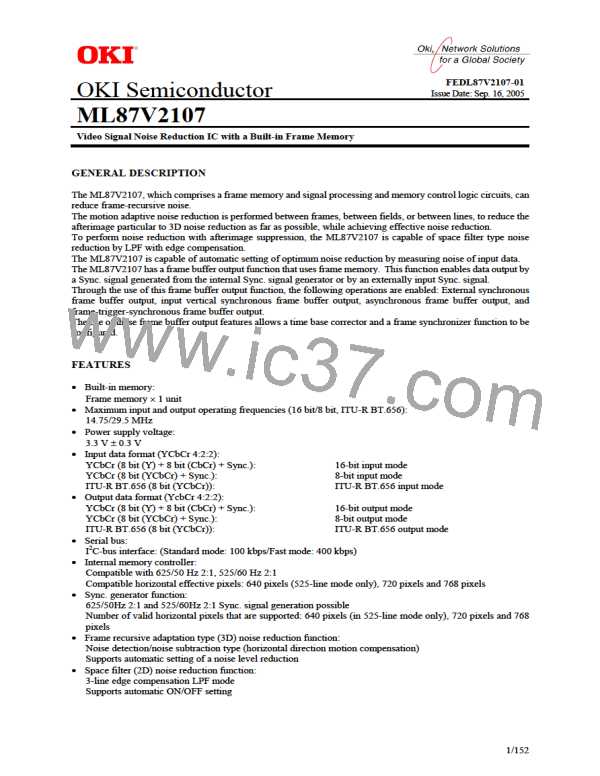FEDL87V2107-01
OKI Semiconductor
ML87V2107
2.2.6 Overtaking Compensation Operation in Frame Buffer Output Function
In the frame buffer output function in any mode other than input vertical synchronous frame buffer output mode,
if ICLK is asynchronous with OCLK, an overtaking phenomenon occurs as shown in Figures 2-2-6(1) and (2) due
to the difference of Sync. signal frequencies between the input (write) side and the output (read) side for the frame
memory, causing repetition of image data or missing image data.
In addition, as shown in Figure 2-2-6(3), in the phase near the overtaking occurrence section, an image (split)
containing the image immediately after input and the previous image occurs.
By setting OTON (SUB: 48h-bit[4]) = 1 in the I2C-bus interface, detect the phase from which overtaking is likely
to occur (detection of area A of the read/write phase difference), and forcibly perform memory address overtaking
during the vertical blanking period to prevent a split from occurring inside a valid image .
In the phase near the overtaking occurrence section, the overtaking detection flag OTA (can be read from SUB:
47h-bit[7]) = 1 is read.
When input synchronization is not stable due to special VTR playback and so on, a split image may occur due to
inability of phase detection.
fvi < fvo
Input
n
n+1
n+2
n+2
n+3
n+4
Output
n
n+1
n+2
n+3
Frame in which image
data is repeated
As the next read processing starts before n+3 is written, n+2 is read twice.
Figure F2-2-6(1) Overtaking When the Frequency in the Input Side is Lower
Frame in which image
fvi > fvo
data is missing
Input
n
n+1
n
n+2
n+3
n+4
Output
n-1
n+1
n+3
n+4
As the n+3 write processing starts before n+2 is
read, n+2 is not read but n+3 is read.
Figure F2-2-6(2) Overtaking When The Frequency is Higher
69/152

 OKI [ OKI ELECTRONIC COMPONETS ]
OKI [ OKI ELECTRONIC COMPONETS ]